Heather's Trike
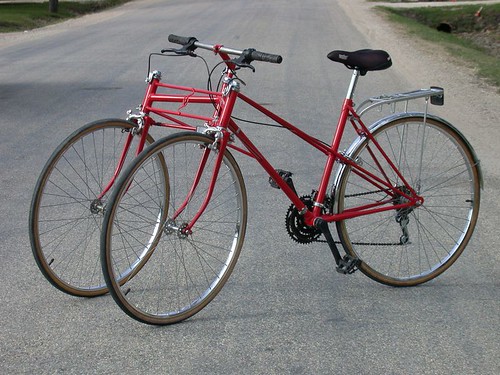 In May of 2003, Colin Bock & I completed building a custom bike project for a woman named Heather.
In May of 2003, Colin Bock & I completed building a custom bike project for a woman named Heather.Heather really enjoys cycling. She used to ride both for recreation and for commuting to work, but Multiple Sclerosis made it impossible for her to ride her mountain bike. Far too often, when she would stop her bike & put her foot down on the road to balance herself, her leg would give out on her & she would fall over. Besides the risk of injury from the fall itself, the added risk falling in front of & being struck by a motor vehicle made this an especially dangerous situation. Heather need a bike that she didn't have to balance when she stopped. What she needed was a tricycle.
 Colin & I began building Heather's trike around an old road bike frame with a low top tube. The women's style top tube was important for Heather to be able to mount & dismount the trike - it would also be helpful if she ever chose to wear a skirt while riding. Aesthetically, the feature I liked the most about this frame was the twin half-inch tubes running from the head tube down to the rear dropouts, rather than a single one-inch top tube.
Colin & I began building Heather's trike around an old road bike frame with a low top tube. The women's style top tube was important for Heather to be able to mount & dismount the trike - it would also be helpful if she ever chose to wear a skirt while riding. Aesthetically, the feature I liked the most about this frame was the twin half-inch tubes running from the head tube down to the rear dropouts, rather than a single one-inch top tube.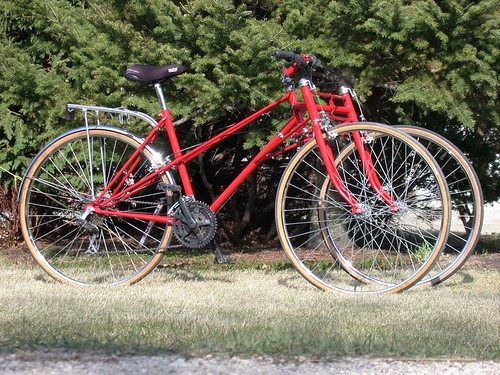 When planning out the design, we opted to make the trike in a tadpole configuration (two wheels in front & one in back) rather than the more typical delta configuration (one wheel in front & two in back). We felt the tadpole would be more stable when turning, plus it would save us having to modify the drive-line of the bike.
When planning out the design, we opted to make the trike in a tadpole configuration (two wheels in front & one in back) rather than the more typical delta configuration (one wheel in front & two in back). We felt the tadpole would be more stable when turning, plus it would save us having to modify the drive-line of the bike.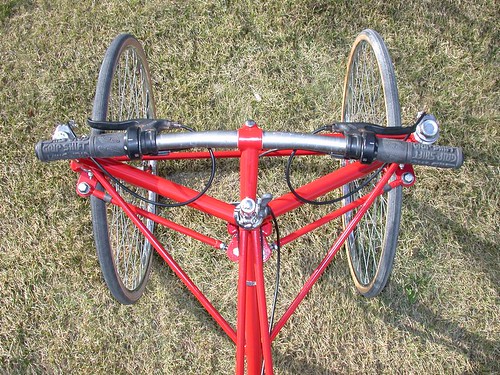 To further improve stability, we placed the two new head tubes six inches forward of the existing head tube. We also placed them as wide as possible while still being able to fit through a standard door.
To further improve stability, we placed the two new head tubes six inches forward of the existing head tube. We also placed them as wide as possible while still being able to fit through a standard door.While we used recycled parts as much as possible for this project, we made the two new head tubes from tube stock we purchased from an aircraft supply company.
We fabricated a jig to lock the two front forks and the frame in their proper positions during construction. We then cut & welded all of the support tubes into place, triangulating the head tubes to the frame & each other.
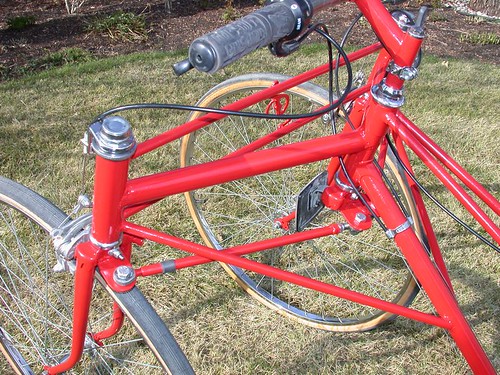 The jig also aided in determining the Ackerman correction needed for the steering linkage. During a turn, the inner wheel needs to travel in a tighter arc than the outer wheel. Ackerman correction allows the wheels to do this.
The jig also aided in determining the Ackerman correction needed for the steering linkage. During a turn, the inner wheel needs to travel in a tighter arc than the outer wheel. Ackerman correction allows the wheels to do this.We used chromed 3/4" knock-out seals to cap the tops of the steer tubes on each fork.
Most of the conventional bike components - handlebars, saddle, drive train, etc. - were scavenged off of Heather's mountain bike and put on the trike.
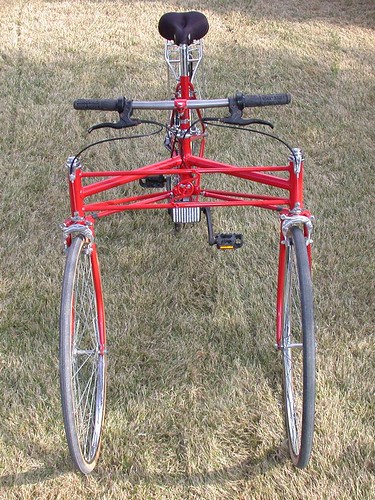 All three wheels have center pull brake calipers. Each of the brake levers on the handle bars operate a single set of brakes on the respective front wheel. An old ten-speed friction shifter with a nice long lever, operates a parking brake on the rear wheel - an important consideration with a tricycle!
All three wheels have center pull brake calipers. Each of the brake levers on the handle bars operate a single set of brakes on the respective front wheel. An old ten-speed friction shifter with a nice long lever, operates a parking brake on the rear wheel - an important consideration with a tricycle!The finished trike surpassed our expectations. We love how it looks and were very impressed with how it handles. Keeping in mind that tricycles handle quite different from bicycles, once you learn how to operate them, they work very well. Fast corners feel especially strange on a trike. However we found that we could take corners as fast as any bike simply by popping the outside front wheel up off the road just before a turn, "bicycling" the trike. This allowed us to lean into corners as we have learned to do on our bikes.
It often takes people a while to wrap their minds around what they are looking at when they see this trike ride by. From certain angles it looks like a regular bike, but then wait, there is an extra front wheel.
Heather tells us that she is very happy with this trike, and she rides it every weekend, weather permitting.
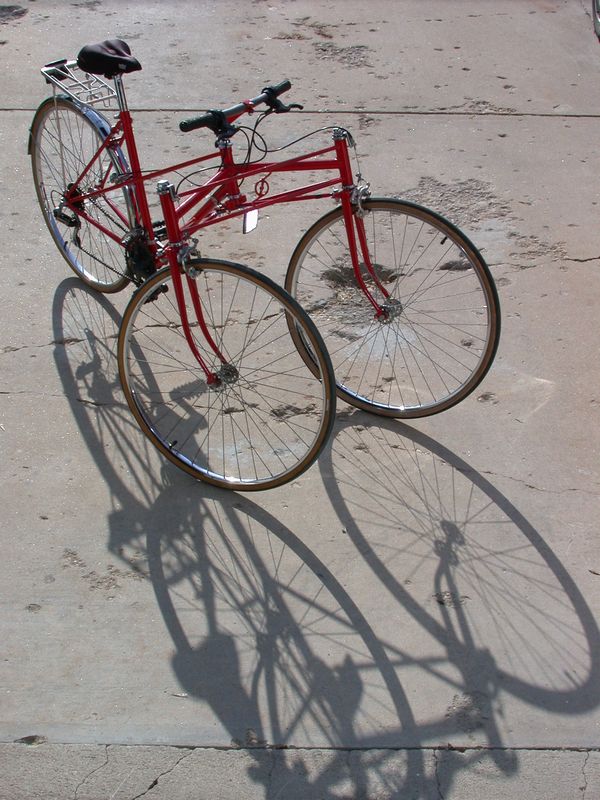

9 Comments:
Just out of curiosity, what's the advantage of the reverse-trike configuration you chose as opposed to a standard trike with two wheels in back?
I imagine it looks cool, but it seems like you're sacrificing the cargo capacity of a standard trike's cargo area between the rear wheels. In addition, I would have some concerns over a forward brake bias and flipping.
I really like how it turned out though, especially the steering mechanism.
Nice trike!
I was wondering if I could post a photo of it in my builder's gallery?...
http://www.atomiczombie.com/main.htm
Cheers!
Brad
Sure thing, Brad! I'd be happy for you to include this trike in
Atomic Zombie's builder's gallery.
By the way, I'm hugely impressed with the custom bikes that you build. Your chopper, Overkill, is too cool.
Did you know that there are devices you can use to activate two brakes from a single lever? You could use such a device to operate both front brakes from a single lever and use the other brake lever to operate the rear brake instead of the lever on the 'gooseneck' that you currently have.
This is a cool trike!
Gruntie
Hey Gruntie. Yep I'm familiar with those brake-cable twining devices that you mentioned. Actually we initially did consider using something like that on this project, however we were concerned that possible unequal brake pressure on the two front wheels would make it handle erratically.
We feel the set up currently on this trike works best. Heather has control over the individual front brakes - handy for turns - and the rear brake is strictly to keep the trike from rolling away when for parked. The chance of braking so hard that Heather might do an endo is remote. The front wheels were moved significantly forward, and on test rides, I was never able to lift the rear wheel while braking. Besides, Heather doesn't ride the trike aggressively.
Thanks for your input!
RICK
Love that bike. I have a friend with MS. She was really into it, even owned a bike shop at one point. Would you consider building another one? Thanks, John.
Would you send me more info on how you corrected for Ackerman? I wasn't able to determine that from the great pics.
Thanks!
Chaz
chaz2000@bellsouth.net
Check out this Wikipedia article on basic Ackerman steering geometry.
I'm impressed! Nice work guys.
Post a Comment
<< Home